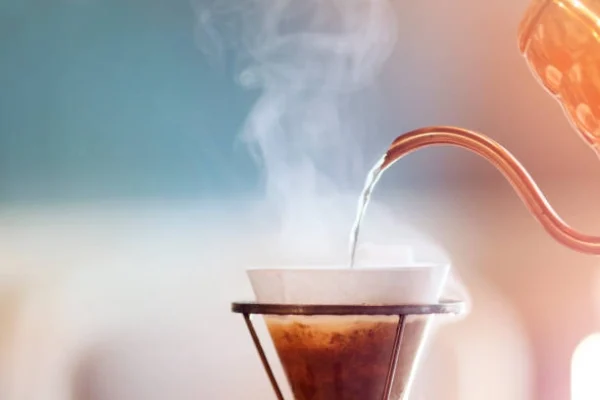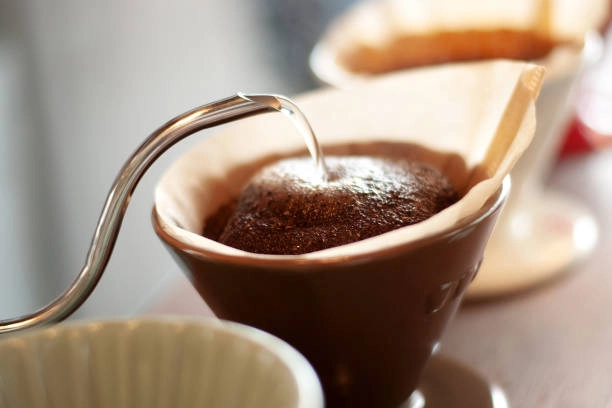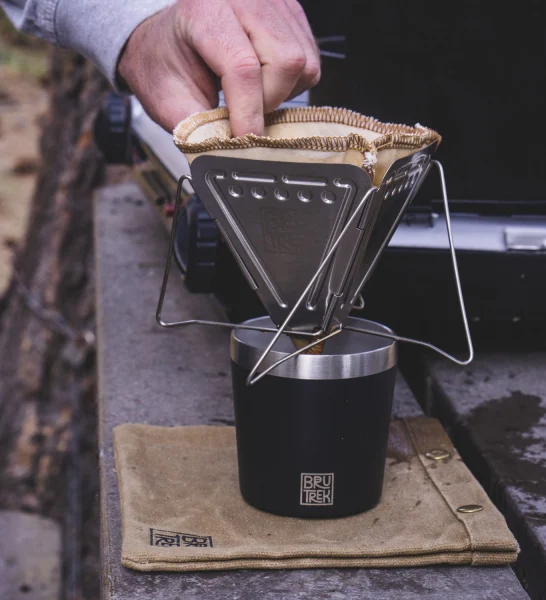How To Make Pour Over Coffee

Pour-over coffee has become increasingly popular among coffee enthusiasts because of its ability to highlight the nuances of flavor in each cup. By allowing water to slowly drip through the coffee grounds, pour over coffee can extract the full flavor potential of each bean. In this guide, we’ll walk you through the steps of making the best pour-over coffee and discuss some of the variables of pour-over coffee.
Step-by-step Pour Over Coffee Guide
Step 1: Choose Your Equipment
To make pour-over coffee, you’ll need a few pieces of equipment. These include a pour-over cone, paper filters, a kettle, and a coffee scale. At BruTrek, we recommend using our Collapsible Pour Over and our CoffeeSock filter for a more sustainable option. Additionally, a gooseneck kettle with a thermometer is useful for precise water temperature control.
Step 2: Heat Your Water
Start by heating your water to the ideal temperature. For pour-over coffee, the water should be between 195°F and 205°F. Using a kettle with a thermometer can help ensure you get the right temperature.
Step 3: Grind Your Coffee
Grind your coffee beans to a medium-fine consistency. The amount of coffee you use will depend on how much coffee you want to make and how strong you prefer your coffee. As a general rule of thumb, use 1 to 2 tablespoons of coffee per 6 ounces of water.
Step 4: Prep Your Filter and Cone
Fold and place the paper filter in the pour-over cone, and then rinse it with hot water. This helps remove any paper taste and warms up the cone. Discard the rinse water.
Step 5: Add Your Coffee Grounds
Place your pour-over cone on top of your coffee mug or carafe and add the coffee grounds to the filter. Gently shake the cone to level out the coffee grounds.
Step 6: Bloom the Coffee
Pour just enough water over the coffee grounds to saturate them completely, and then wait 30 seconds. This process, known as blooming, allows the coffee to release its initial gases and prepares it for brewing.
Step 7: Brew Your Coffee
Slowly pour the rest of the hot water over the coffee grounds in a circular motion. Start at the center and work your way outward. Keep pouring until you have used all the water. Aim to finish brewing within 2 to 4 minutes.
Step 8: Enjoy Your Coffee
Once the brewing is complete, remove the pour-over cone from your mug or carafe. Discard the used coffee grounds and filter. Take a moment to appreciate the aroma and flavor of your freshly brewed pour-over coffee.
By following these simple steps, you can make the best pour-over coffee possible. Remember to experiment with different coffee beans, water temperatures, and brewing times to find the perfect cup for your taste buds. If you want to learn about the difference between french press and pour-over coffee, read here.

What is
Coffee Bloom?
Coffee bloom is a term used to describe the process of degassing coffee beans when hot water is poured over them during the brewing process. When coffee beans are roasted, they release gases like carbon dioxide, which can affect the flavor of the coffee if not allowed to escape before brewing.
During the bloom, the hot water reacts with the carbon dioxide in the coffee grounds, causing them to release gas and create a foamy layer on top of the coffee. This process is important because it helps to ensure that the coffee is brewed evenly and that all the flavors are extracted properly.
Pour-over coffee is well-known for producing an impressive coffee bloom. This is because the pour-over method allows for more control over the brewing variables, which can result in a more consistent and uniform extraction of flavor and aroma compounds.
When you pour hot water over coffee grounds, the water causes the gases trapped inside the coffee beans to expand and escape. This is known as the coffee bloom, and it’s an important indicator of the freshness and quality of the coffee. A good coffee bloom should be robust, with lots of bubbles and foam, and should last for at least 30 seconds.
The pour-over method is particularly effective at producing a good coffee bloom because the slow and steady pour of hot water allows the coffee grounds to become fully saturated, creating the ideal environment for the gases to escape. Additionally, the filter used in pour-over brewing helps to trap any excess gas, preventing it from escaping too quickly and reducing the quality of the coffee bloom.
Overall, the coffee bloom is a crucial aspect of the pour-over coffee experience, as it indicates that the coffee is fresh and of high quality. By using the pour-over method, you can ensure that you are getting the most out of your coffee beans and experiencing all the subtle nuances of flavor and aroma that they have to offer.
Learn all about Coffee Bloom in our blog post here.
How to Optimize Water Quality for the Best Pour-Over Coffee
Water is an essential component of pour-over coffee, and the quality of the water can have a significant impact on the taste of your coffee. The type of water used in pour over coffee should be free from impurities and minerals that can affect the taste of the coffee.
To ensure the best possible water quality, it is recommended to use filtered water. A good water filtration system can remove impurities like chlorine and sediment, resulting in cleaner and better-tasting water. If you do not have access to a water filtration system, you can also use bottled water or boil tap water to remove impurities.
Another important factor in the quality of the water used in pour over coffee is the temperature. The ideal water temperature for pour-over coffee is between 195-205°F (90-96°C). Water that is too hot can result in over-extracted and bitter coffee, while water that is too cold can result in under-extracted and sour coffee.
To ensure the proper temperature, it is recommended to use a kettle with a built-in thermometer or a separate thermometer to measure the water temperature. Alternatively, you can heat the water in a pot and use a thermometer to check the temperature before pouring it over the coffee.
It’s also important to note that different types of coffee beans may require different water temperatures to bring out their unique flavor profiles. Lighter roasts may benefit from slightly cooler water, while darker roasts may require hotter water.
Choosing your filter for Pour-Over Coffee

When it comes to making pour-over coffee, the filter you use can greatly impact the taste of the final product. There are two main types of filters used in pour-over brewing: paper and metal. Both have their advantages and disadvantages, and ultimately, the choice between the two comes down to personal preference. In this article, we’ll explore the impact of different types of coffee filters on the taste of pour-over coffee, and offer some tips on how to choose the right filter for your brewing style.
Paper Filters:
Paper filters are the most commonly used filter in pour-over coffee brewing. They are made from a thin, porous paper that allows water to pass through while capturing coffee grounds and oils. One of the main advantages of paper filters is that they produce a very clean and crisp cup of coffee. The paper helps to remove any sediment or oils from the coffee, resulting in a smooth and consistent flavor. Paper filters also tend to be more affordable and widely available than metal filters.
However, some coffee drinkers find that paper filters can absorb some of the flavor and aroma of the coffee, leading to a slightly muted taste. In addition, paper filters can create more waste and environmental impact, as they are not reusable.
Metal Filters:
Metal filters, also known as “permanent” filters, are made from stainless steel or other types of mesh material. They are reusable and do not produce any waste, making them a more sustainable option than paper filters. Metal filters also allow more oils and sediment to pass through into the final cup of coffee, which can lead to a fuller and richer taste.
However, some coffee drinkers find that metal filters can produce a slightly bitter or metallic taste in the coffee. In addition, metal filters can be more expensive than paper filters, and may require more maintenance to keep clean and functioning properly.
Organic Cotton Filters:
Organic cotton filters are a sustainable and eco-friendly alternative to traditional paper or metal filters for pour-over coffee brewing. These filters are made from organic cotton, which is grown without the use of harmful chemicals, making them a great choice for environmentally conscious coffee lovers.
One of the main benefits of using organic cotton filters is that they are reusable. Unlike paper filters that need to be disposed of after each use, organic cotton filters can be washed and used again and again. This not only saves money in the long run but also reduces waste and the environmental impact of disposable filters.
In addition to being sustainable, organic cotton filters can also enhance the taste of your pour-over coffee. Unlike paper filters, which can trap some of the coffee’s natural oils and flavors, organic cotton filters allow these elements to pass through, resulting in a fuller-bodied and more flavorful cup of coffee.
When using organic cotton filters, it’s important to properly clean and maintain them to ensure they continue to function properly. After each use, the filter should be rinsed with hot water and allowed to air dry completely before being stored. It’s also recommended to boil the filter periodically to remove any buildup of coffee oils or residue.
Take a look at our Collapsible Pour Over and our collaboration with CoffeeSock, which offers two reusable organic cotton filters included with every purchase.
How to Choose the Right Type of Coffee Beans for Pour Over Coffee
Pour-over coffee is a delicate and nuanced brewing method that allows the unique flavor notes of coffee beans to shine through. However, the type of coffee beans you choose will play a significant role in the taste of your final cup. Here are some tips for choosing the right beans for pour-over brewing.
- Consider the flavor profile: Different coffee beans have different flavor profiles, ranging from fruity and floral to nutty and chocolatey. Consider what kind of flavors you prefer in your coffee and choose beans that match those preferences. For example, if you like bright and acidic coffee, go for beans from Ethiopia. If you prefer a nutty and chocolatey taste, consider beans from Brazil.
- Pay attention to the roast level: The roast level of the beans can also impact the flavor of your pour-over coffee. Lighter roasts tend to highlight the unique characteristics of the beans, while darker roasts can impart a smokier, more robust flavor. However, it’s important to note that over-roasting can mask the natural flavors of the beans, so aim for a roast level that complements rather than overwhelms the taste.
- Choose high-quality beans: To get the best possible pour-over coffee, it’s important to choose high-quality beans. Look for beans that are freshly roasted and sourced from reputable coffee growers. Specialty coffee shops or online retailers are good places to start your search.
- Experiment with different beans: Finally, don’t be afraid to experiment with different types of beans to find your perfect cup of pour-over coffee. Try different origins, roast levels, and blends to discover what you like best. You may be surprised at how much variation there can be in the taste of different beans.
Making pour-over coffee is not just a method, but it’s also an art. By using high-quality beans, properly filtered and heated water, and mastering the pouring technique, you can create a delicious and unique cup of coffee every time. Don’t be afraid to experiment with different brewing variables and adjust your technique to find the perfect balance of flavor and aroma. With practice and patience, you can become a pour-over coffee master and enjoy a rich and satisfying cup of coffee.
